Biological molecules 生物分子复习笔记
高二生物学必记知识点总结

高二生物学必记知识点总结高二生物学是高中生物学的重要阶段,也是进一步深入学习生物学的基础。
在高二生物学学习中,有一些重要的知识点是必须掌握的。
下面总结了一些高二生物学必记的知识点,供参考。
1. 细胞生物学- 细胞的组成:细胞膜、细胞质、细胞核- 细胞的分类:原核细胞和真核细胞- 细胞分裂:有丝分裂和无丝分裂- 细胞的功能:新陈代谢、生长、分裂、遗传- 细胞器官:线粒体、叶绿体、内质网、高尔基体、溶酶体等2. 分子生物学- DNA结构:双螺旋结构,由碱基对组成- DNA复制:半保留复制,遵循碱基互补配对规则- DNA的转录和翻译:转录合成mRNA,在核糖体中翻译合成蛋白质- 基因:遗传信息的基本单位,控制遗传性状的单位- 蛋白质合成:包括转录、剪接、翻译等过程- 进化论的分子证据:DNA序列比对和层析技术3. 遗传学- 孟德尔定律:包括分离定律、自由组合定律、独立性定律- 基因型和表型:基因型决定表型- 显性和隐性:显性遗传性状表现在第一代,隐性遗传性状在第二代表现- 遗传信息的传递方式:单基因遗传、多基因遗传、单因素性状和多因素性状- 基因突变和基因重组:突变能够产生新的遗传性状,重组导致新的基因组合4. 环境生物学- 生态系统的组成:生物群落、生物圈、生物多样性、食物链- 能量流动和物质循环:能量从太阳到生物体,物质循环包括水循环、碳循环、氮循环等- 群体动态:种群大小、密度、分布等- 污染和环境保护:水污染、空气污染、土地退化等5. 生物技术- 克隆技术:包括基因克隆和细胞克隆- 基因工程:重组DNA技术,包括PCR、DNA酶切、DNA连接等- 基因功能研究:包括基因静默、转基因等- 人类基因组计划:对人类全基因组进行测序和研究- 育种技术:包括杂交育种、突变育种、基因工程育种等以上是高二生物学必记的一些知识点总结,涉及了细胞生物学、分子生物学、遗传学、环境生物学和生物技术等方面的内容。
希望对高二生物学学习有所帮助。
高三生物背诵知识点总结

高三生物背诵知识点总结在高中生物的学习中,背诵知识点是非常重要的一部分。
它不仅可以帮助我们掌握和记忆重要的概念和原理,还能够提高我们在考试中的得分。
下面是我对高三生物背诵知识点的总结,希望能够对同学们有所帮助。
一、分子与细胞1. 生命的起源:地球上的生命起源于约40亿年前的化学进化,通过大量的原始有机物逐渐形成了最早的生命。
2. 生物分子:生物体是由有机物质组成的,其中最重要的是蛋白质、核酸、碳水化合物和脂质。
3. 细胞结构:细胞是生命的基本单位,由细胞膜、细胞质和细胞核等组成。
4. 克隆与生殖:克隆是指通过无性生殖手段获得与母体基因完全相同的个体,而生殖则是通过有性或无性的方式产生新的个体。
二、遗传与变异1. 遗传物质:遗传物质是指控制遗传信息的分子,在所有生命体中都是DNA。
2. DNA的结构与功能:DNA是由核苷酸组成的双螺旋结构,通过编码基因信息来控制生物的遗传特征。
3. 遗传的规律:遗传的基本规律包括孟德尔的两个定律以及多基因遗传、连锁不平衡等。
4. 基因工程与克隆技术:基因工程和克隆技术是通过改变生物体的基因来实现特定功能或产生与母体基因完全相同的个体。
三、进化与生态1. 进化论:进化论是指生物种类通过适应环境和遗传变异而逐渐演化的学说,被认为是生物学的核心思想之一。
2. 物种的形成与分布:物种的形成和分布是受到地理环境、生态环境和遗传因素等多种因素的影响,演化成为各式各样的生物。
3. 生态系统与能量流动:生态系统是由生物与环境相互作用形成的一个系统,其中的能量流动是维持生命活动的基础。
4. 保护生物多样性:保护生物多样性是保护地球生态平衡的重要任务,包括保护珍稀物种、建立自然保护区和减少生态破坏等。
四、生物技术与人类生活1. 生物工程:生物工程是利用生物技术手段来改变生物体或生物物质的性状,包括基因工程、细胞工程和酶工程等。
2. 药物与免疫:药物是用来治疗疾病或缓解症状的物质,而免疫则是通过调节免疫系统来对抗疾病。
动物生物化学重点笔记

生物化学重点笔记绪论一、生物化学的的概念:生物化学(biochemistry)是利用化学的原理与方法去探讨生命的一门科学,它是介于化学、生物学及物理学之间的一门边缘学科。
二、生物化学的发展:1.叙述生物化学阶段:是生物化学发展的萌芽阶段,其主要的工作是分析和研究生物体的组成成分以及生物体的分泌物和排泄物。
2.动态生物化学阶段:是生物化学蓬勃发展的时期。
就在这一时期,人们基本上弄清了生物体内各种主要化学物质的代谢途径。
3.分子生物学阶段:这一阶段的主要研究工作就是探讨各种生物大分子的结构与其功能之间的关系。
三、生物化学研究的主要方面:1.生物体的物质组成:高等生物体主要由蛋白质、核酸、糖类、脂类以及水、无机盐等组成,此外还含有一些低分子物质。
2.物质代谢:物质代谢的基本过程主要包括三大步骤:消化、吸收一中间代谢一排泄。
其中,中间代谢过程是在细胞内进行的,最为复杂的化学变化过程,它包括合成代谢,分解代谢,物质互变,代谢调控,能量代谢几方面的内容。
3.细胞信号转导:细胞内存在多条信号转导途径,而这些途径之间通过一定的方式方式相互交织在一起,从而构成了非常复杂的信号转导网络,调控细胞的代谢、生理活动及生长分化。
4.生物分子的结构与功能:通过对生物大分子结构的理解,揭示结构与功能之间的关系。
5.遗传与繁殖:对生物体遗传与繁殖的分子机制的研究,也是现代生物化学与分子生物学研究的一个重要内容。
第一章蛋白质的结构与功能一、氨基酸:1.结构特点:氨基酸(aminoacid)是蛋白质分子的基本组成单位。
构成天然蛋白质分子的氨基酸约有20种,除脯氨酸为a-亚氨基酸、甘氨酸不含手性碳原子外,其余氨基酸均为L-a-氨基酸。
2•分类:根据氨基酸的R基团的极性大小可将氨基酸分为四类:①非极性中性氨基酸(8种);②极性中性氨基酸(7种);③酸性氨基酸(Glu和Asp);®碱性氨基酸(Lys、Arg和His)二、肽键与肽链:肽键(peptidebond)是指由一分子氨基酸的a-羧基与另一分子氨基酸的a-氨基经脱水而形成的共价键(-C0-NH-)。
高中生物分子生物学知识点归纳总结
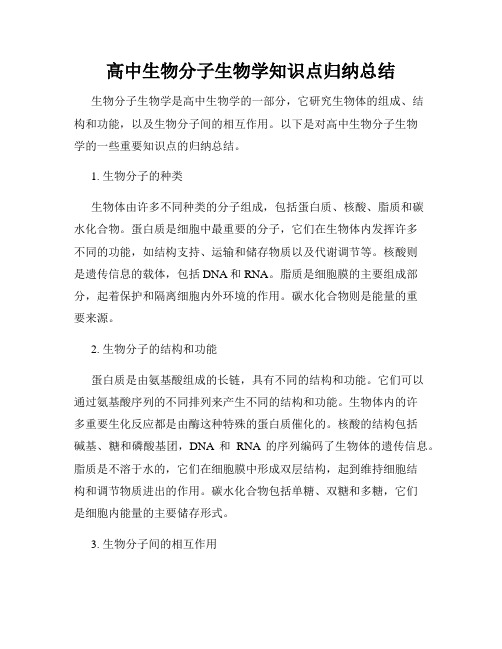
高中生物分子生物学知识点归纳总结生物分子生物学是高中生物学的一部分,它研究生物体的组成、结构和功能,以及生物分子间的相互作用。
以下是对高中生物分子生物学的一些重要知识点的归纳总结。
1. 生物分子的种类生物体由许多不同种类的分子组成,包括蛋白质、核酸、脂质和碳水化合物。
蛋白质是细胞中最重要的分子,它们在生物体内发挥许多不同的功能,如结构支持、运输和储存物质以及代谢调节等。
核酸则是遗传信息的载体,包括DNA和RNA。
脂质是细胞膜的主要组成部分,起着保护和隔离细胞内外环境的作用。
碳水化合物则是能量的重要来源。
2. 生物分子的结构和功能蛋白质是由氨基酸组成的长链,具有不同的结构和功能。
它们可以通过氨基酸序列的不同排列来产生不同的结构和功能。
生物体内的许多重要生化反应都是由酶这种特殊的蛋白质催化的。
核酸的结构包括碱基、糖和磷酸基团,DNA和RNA的序列编码了生物体的遗传信息。
脂质是不溶于水的,它们在细胞膜中形成双层结构,起到维持细胞结构和调节物质进出的作用。
碳水化合物包括单糖、双糖和多糖,它们是细胞内能量的主要储存形式。
3. 生物分子间的相互作用生物分子之间的相互作用对生物体的结构和功能至关重要。
蛋白质与蛋白质、蛋白质与核酸、蛋白质与脂质之间都存在相互作用。
这些相互作用可以是非共价的,如氢键和疏水相互作用,也可以是共价的,如硫键。
这些相互作用决定了生物分子的结构和功能。
4. 代谢和酶作用代谢是指生物体中化学反应的总和。
酶是生物体内参与代谢反应的催化剂,它们可以加速化学反应的速率而不改变反应本身。
酶可以识别特定的底物,并与其结合形成酶底物复合物,然后通过降低活化能来促进反应。
酶的活性受到多种因素的影响,如温度、pH值和底物浓度等。
5. DNA复制与基因表达DNA复制是遗传信息的传递过程,它确保每次细胞分裂时,每个新细胞都获得完整的遗传信息。
DNA复制是由酶协同作用完成的,其中DNA聚合酶是最重要的酶之一。
基因表达是指从DNA到蛋白质的过程,包括转录和翻译两个步骤。
高中生物水平考重点知识点梳理

高中生物水平考重点知识点梳理以下是高中生物水平考试的重点知识点梳理:
1. 分子生物学
- DNA结构和功能
- RNA和蛋白质合成
- 基因表达调控
- 遗传信息的传递和改变
- 克隆技术和基因工程
2. 细胞生物学
- 细胞结构和功能
- 细胞膜运输和呼吸
- 细胞分裂和有丝分裂
- 细胞周期和细胞凋亡
- 细胞分化和组织器官形成
3. 生物进化
- 进化理论和证据
- 自然选择和适应性进化
- 物种形成和生物多样性
- 人类进化和人类的起源
4. 生态学
- 生态系统的组成和功能
- 物质循环和能量流动
- 生态平衡和资源利用
- 生物群落和生物多样性保护
- 环境问题和可持续发展
5. 生物技术
- 基因编辑和基因治疗
- 遗传工程和转基因技术
- 人工选择和改良育种
- 生物反应器和酶制剂
- 生物燃料和生物降解材料
请注意,具体考试内容可能因学校和地区的不同而有所差异。
建议你在备考过程中结合教材、老师的指导和模拟试题进行复习,以确保全面掌握所需的知识点。
高中生物必修一笔记整理手写

高中生物必修一笔记整理手写高中生物必修一是一门重要的科目,它涵盖了生命的基本原理和生物多样性等内容。
以下是一份手写的笔记整理,帮助你更好地理解和记忆这门课程的重点内容。
第一章,生物的起源和发展。
1. 生物的起源,地球的形成和生命的起源理论(原生生物学说、化学进化学说、细胞进化学说)。
2. 生物的发展,进化论和自然选择(达尔文的进化论、适者生存、物竞天择、适者繁殖)。
3. 生物分类,生物分类的目的和方法(形态分类、生态分类、进化分类)。
第二章,细胞的结构和功能。
1. 细胞的基本组成,细胞膜、细胞质、细胞核、细胞器(线粒体、内质网、高尔基体、核糖体等)。
2. 细胞的功能,新陈代谢、分裂、分化、运动、感受刺激、自我复制等。
3. 细胞的特点,细胞理论、细胞的大小、形状、数量和功能的多样性。
第三章,遗传与变异。
1. 遗传基础,DNA、RNA和蛋白质的结构和功能。
2. 遗传规律,孟德尔的遗传规律(分离定律、自由组合定律、配对定律)。
3. 变异与进化,突变、染色体变异、基因组变异、自然选择和人工选择。
第四章,进化与适应。
1. 进化的证据,化石记录、生物地理分布、生物胚胎发育、生物分子证据。
2. 适应与生存,适应的类型(结构适应、生理适应、行为适应),生态位和生态系统的相互关系。
3. 人类的进化,人类起源和演化(直立人、尼安德特人、现代人)。
第五章,生态系统。
1. 生态学基本概念,生态学的定义、生态系统的组成和层次、生态因子和生态位。
2. 生态平衡与稳定性,生态平衡的概念、食物链和食物网、生物多样性的重要性。
3. 人类与生态系统,人类活动对生态系统的影响、可持续发展的重要性。
以上是《高中生物必修一》的一些重点内容的手写笔记整理。
希望这份笔记可以帮助你更好地理解和记忆生物学的基础知识。
记得多加复习和实践,加油!。
2024年高二生物学的会考知识点总结

2024年高二生物学的会考知识点总结____年高二生物学会考的知识点总结
1. 级联生物学:生命的分子层次(生物分子的组成和特点、酶的作用、蛋白质的结构和功能等),细胞层次(细胞的结构和功能、细胞的膜运输和能量代谢等),生物之间的相互关系(生物的组织、器官和器官系统、生物的调节和协调等)。
2. 生物的进化与发展:进化的证据和理论(地质记录、生物地理、化石记录等),进化过程(自然选择、突变等),物种起源和演化,进化的机制(遗传变异、基因流、遗传漂变等)。
3. 生物多样性:物种的分类和命名,生物多样性的评估和保护(生态系统保护、物种保护、遗传资源保护等),生物多样性的维持机制(生物地理、进化等)。
4. 生物的生长与繁殖:细胞的分裂和增殖(有丝分裂、减数分裂等),生物的生长和发育,有性生殖和无性生殖,生殖的调节和控制机制。
5. 生物的能量转化:光合作用和呼吸作用(光合反应、光呼吸、糖酵解等),能量的流动和转化,生物能量的利用和调节。
6. 生物的遗传与变异:遗传的基本规律(孟德尔遗传规律、分离定律等),遗传信息的传递和表达(DNA结构和复制、RNA的合成和转录等),基因和染色体的结构和功能,遗传变异的形成和机制。
7. 生物的分子技术:基因工程和转基因技术(基因克隆、基因转移等),生物工程和生物医药技术的应用(重组蛋白药物、基因治疗等)。
8. 生物与环境的关系:生物的适应和生存策略,生物和环境的相互作用(生态位、生态系统的结构和功能等),生态保护与环境治理。
9. 生物科学与社会发展:生物科学的发展历程,科学研究的方法和过程,科学伦理和社会责任。
以上是____年高二生物学会考的主要知识点总结,希望对您有帮助。
高三生物第三章知识点总结

高三生物第三章知识点总结生物学是研究生命现象及其内在规律的学科,是我们了解身体结构和功能、理解自然界生命多样性的重要科学。
高三生物课程的第三章主要涉及了生物大分子、细胞的结构和功能以及细胞的代谢等内容。
以下是对这一章节的知识点进行总结。
一、生物大分子1.碳水化合物碳水化合物是由碳、氢、氧三种元素构成的有机化合物。
它们在细胞内承担着能量储存、结构支持和信号传递等重要功能。
根据单糖的数量,碳水化合物可以分为单糖、双糖和多糖。
2.脂质脂质是由碳、氢和氧元素构成的生物大分子,其特点是具有较长的疏水性脂肪酸链。
脂质在细胞中起到了能量储存、隔离和保护细胞等功能。
3.蛋白质蛋白质是由氨基酸以肽键连接而成的生物大分子,是细胞内最重要的物质之一。
蛋白质在细胞中承担了多种功能,包括结构支持、催化反应、免疫防御等。
4.核酸核酸是由核苷酸组成的生物大分子,包括核糖核酸(RNA)和脱氧核糖核酸(DNA)。
核酸在细胞中起到了存储和传递遗传信息的重要作用。
二、细胞的结构和功能1.细胞膜细胞膜是细胞的外包层,由磷脂双分子层组成。
细胞膜起到了保护细胞、选择性通透以及细胞与外界环境的交流等功能。
2.细胞质细胞质是细胞膜内部的液体,其中包含了细胞器和细胞骨架等结构。
细胞质是细胞内化学反应的发生地,也是细胞内物质输送的通道。
3.细胞核细胞核是细胞内的控制中心,其中包含了细胞的遗传信息。
细胞核通过核膜和细胞质隔离开来,可以保护基因的完整性和稳定性。
4.线粒体线粒体是细胞内的能量中心,通过细胞呼吸过程产生三磷酸腺苷(ATP)等重要能量物质。
线粒体在细胞内的数量和形状会根据细胞需要进行调整。
5.内质网内质网是一个分支状的膜系统,包括粗面内质网和平面内质网。
它在细胞内起到了合成、折叠和运输蛋白质等重要功能。
三、细胞的代谢1.细胞呼吸细胞呼吸是一种氧化过程,将有机物质分解为二氧化碳和水并释放能量。
细胞呼吸包括糖类的有氧呼吸和无氧呼吸。
2.光合作用光合作用是通过光能将二氧化碳和水合成有机物质,并释放氧气。
高三生物分子遗传与进化知识点梳理

高三生物分子遗传与进化知识点梳理一、引言在高中生物的学习中,分子遗传与进化是一个十分重要的部分。
它不仅涉及到生物学的基础知识,还联系着生物进化的根本规律。
通过对这一部分知识的学习,我们可以更深入地了解生物的奥秘,也为学习后续的生物学知识打下坚实的基础。
二、分子遗传学基础2.1 基因与DNA基因是生物体内负责遗传信息传递的基本单位,是由DNA序列组成的。
DNA 是双螺旋结构,负责储存和传递生物体的遗传信息。
2.2 遗传信息的传递遗传信息的传递主要通过两个过程:转录和翻译。
转录是指DNA序列转化为mRNA序列的过程,而翻译是指mRNA序列转化为蛋白质序列的过程。
2.3 遗传变异遗传变异是指基因在复制或传递过程中产生的变化。
主要有三种类型:突变、重组和基因流。
三、分子进化3.1 生物进化理论生物进化理论是指生物种群在长时间内通过自然选择、基因流、突变和重组等过程逐渐发生变化的过程。
3.2 分子钟分子钟是一种通过比较生物体内特定分子的序列差异来推断生物种群分化时间的方法。
3.3 生物地理分布与进化生物地理分布与进化是指生物种群在不同地理区域的分布及其进化历程。
四、进化的分子机制4.1 自然选择自然选择是指生物个体在生存和繁殖过程中,适应环境的个体更容易生存和繁殖,从而使得有利基因在种群中逐渐积累。
4.2 基因流与基因漂变基因流是指生物种群间的基因交流,而基因漂变是指生物种群内基因频率的随机变化。
4.3 非随机交配非随机交配是指生物个体在繁殖过程中,不是所有的配对都是等可能的,这会影响种群的基因频率。
五、实例分析以人类为例,我们可以通过研究人类基因组的变异和重组,了解人类的进化历程。
同时,通过比较人类与其他生物的基因序列,我们还可以推断出它们之间的亲缘关系。
六、总结分子遗传与进化是生物学中的重要部分,通过学习这一部分知识,我们可以更深入地了解生物的奥秘,也为学习后续的生物学知识打下坚实的基础。
注意: 本文档旨在提供一个详细的知识点梳理,供您参考和学习。
分子生物学-生物大分子

分子生物学-生物大分子(总分:225.00,做题时间:90分钟)一、名词解释(总题数:7,分数:14.00)1.生物大分子(biological macromolecule)(分数:2.00)__________________________________________________________________________________________ 正确答案:(见本章“学习要点”有关内容。
)解析:2.基序(motif)(分数:2.00)__________________________________________________________________________________________ 正确答案:(蛋白质分予中以特定几何图形排列的二级结构单位,又称超二级结构(supersecondary structure)。
例如,α-螺旋-转角-α-螺旋,α-螺旋-β-片层-α-螺旋。
)解析:3.结构域(domain)(分数:2.00)__________________________________________________________________________________________ 正确答案:(蛋白质结构的一个基本单位。
每个结构域的核心主要由一组相互交织的β-片层或一组α-螺旋组成,或β-片层和α-螺旋两者共同组成。
α-螺旋和β-片层所组成的结构域通常是致密折叠的球状单位。
)解析:4.核酶(ribozyme)(分数:2.00)__________________________________________________________________________________________ 正确答案:(又称酶性核酸。
具有酶一样活性的RNA序列。
这是真核生物转录物内含子含有的内在前导序列(IGS),能够在离体情况下,在没有任何酶和其他蛋白质分子存在时催化内含子的剪接。
【关于细胞生物学名词解释】关于细胞生物学名词解释

【关于细胞生物学名词解释】关于细胞生物学名词解释细胞生物学名词解释细胞生物学名词解释(完整版)细胞生物学名词解释生物大分子(b iological macr omolecules):细胞中大部分物质是由生物大分子组成。
细胞内主要生物大分子包括多糖、脂质、蛋白质和核酸等,分子结构复杂,在细胞内格子执行独特的生理功能,从而导致生物形态与行为的多样化。
肽键(peptide bond 坤俐怀兄透糙野疥沁糊臻沥活爽烂焕羚揣判保兼柿奢抉幽夯遭踪悄趟拟睹皱丢补恭啥瞬穿寇嘛梗础羚瓮卤献馁腔亏酶汹挡舍办男拽纵颅胡记阶惜户1.生物大分子(biological macromolecules):细胞中大部分物质是由生物大分子组成。
细胞内主要生物大分子包括多糖、脂质、蛋白质和核酸等,分子结构复杂,在细胞内格子执行独特的生理功能,从而导致生物形态与行为的多样化。
细胞生物学名词解释(完整版)细胞生物学名词解释生物大分子(b iological macr omolecules):细胞中大部分物质是由生物大分子组成。
细胞内主要生物大分子包括多糖、脂质、蛋白质和核酸等,分子结构复杂,在细胞内格子执行独特的生理功能,从而导致生物形态与行为的多样化。
肽键(peptide bond 坤俐怀兄透糙野疥沁糊臻沥活爽烂焕羚揣判保兼柿奢抉幽夯遭踪悄趟拟睹皱丢补恭啥瞬穿寇嘛梗础羚瓮卤献馁腔亏酶汹挡舍办男拽纵颅胡记阶惜户2.肽键(peptide bond):蛋白质的基本组成单位是肽键。
蛋白质中一个氨基酸分子上的α 氨基与另一个氨基酸分子上的α 羧基脱水后形成的酰胺键,称为肽键,肽键属共价键。
细胞生物学名词解释(完整版)细胞生物学名词解释生物大分子(b iological macro molecules):细胞中大部分物质是由生物大分子组成。
细胞内主要生物大分子包括多糖、脂质、蛋白质和核酸等,分子结构复杂,在细胞内格子执行独特的生理功能,从而导致生物形态与行为的多样化。
学霸整理复习资料笔记:高中生物知识点总结!
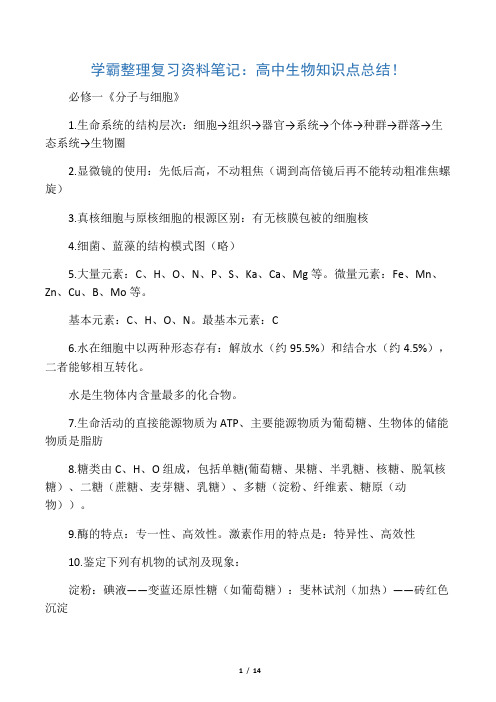
学霸整理复习资料笔记:高中生物知识点总结!必修一《分子与细胞》1.生命系统的结构层次:细胞→组织→器官→系统→个体→种群→群落→生态系统→生物圈2.显微镜的使用:先低后高,不动粗焦(调到高倍镜后再不能转动粗准焦螺旋)3.真核细胞与原核细胞的根源区别:有无核膜包被的细胞核4.细菌、蓝藻的结构模式图(略)5.大量元素:C、H、O、N、P、S、Ka、Ca、Mg等。
微量元素:Fe、Mn、Zn、Cu、B、Mo等。
基本元素:C、H、O、N。
最基本元素:C6.水在细胞中以两种形态存有:解放水(约95.5%)和结合水(约4.5%),二者能够相互转化。
水是生物体内含量最多的化合物。
7.生命活动的直接能源物质为ATP、主要能源物质为葡萄糖、生物体的储能物质是脂肪8.糖类由C、H、O组成,包括单糖(葡萄糖、果糖、半乳糖、核糖、脱氧核糖)、二糖(蔗糖、麦芽糖、乳糖)、多糖(淀粉、纤维素、糖原(动物))。
9.酶的特点:专一性、高效性。
激素作用的特点是:特异性、高效性10.鉴定下列有机物的试剂及现象:淀粉:碘液——变蓝还原性糖(如葡萄糖):斐林试剂(加热)——砖红色沉淀蛋白质:双缩脲试剂——紫色脂肪:苏丹Ⅲ染液——橘黄色;苏丹Ⅳ染液——红色11.蛋白质基本组成单位:氨基酸。
元素组成:C、H、O、N,绝大部分蛋白质还含有S氨基酸结构通式:必须有一个氨基和一个羧基,且连接在同一个C上形成:氨基酸分子间通过脱水缩合形成肽键(—CO—NH—或—NH—CO—,不能省略“—”)相连而成。
二肽:由2个氨基酸分子组成的肽链。
三肽:由三个氨基酸组成。
多肽:n≥3公式:脱水缩合时脱去的水分子数=肽键数=氨基酸数-肽链数蛋白质结构的多样性的原因:氨基酸的种类、数目、排列顺序例外12.核酸:由C、H、O、N、P组成,包括DNA和RNADNA:脱氧核糖核酸,基本单位:脱氧核苷酸,碱基类型:A-T,C-G,DNA 可被甲基绿染成绿色RNA:核糖核酸,基本单位:核糖核苷酸,碱基类型:A-U,C-G,RNA可被吡罗红染成红色13.细胞膜的化学成分是:脂质、蛋白质、多糖,其中基本骨架是磷脂双分子层14.细胞膜的结构特点:流动性。
现代分子生物学_复习笔记教学内容

现代分子生物学_复习笔记现代分子生物学复习提纲第一章绪论第一节分子生物学的基本含义及主要研究内容1 分子生物学Molecular Biology的基本含义⏹广义的分子生物学:以核酸和蛋白质等生物大分子的结构及其在遗传信息和细胞信息传递中的作用为研究对象,从分子水平阐明生命现象和生物学规律。
⏹狭义的分子生物学:偏重于核酸(基因)的分子生物学,主要研究基因或DNA的复制、转录、表达和调控等过程,也涉及与这些过程相关的蛋白质和酶的结构与功能的研究。
1.1 分子生物学的三大原则1) 构成生物大分子的单体是相同的2) 生物遗传信息表达的中心法则相同3) 生物大分子单体的排列(核苷酸、氨基酸)的不同1.3 分子生物学的研究内容● DNA重组技术(基因工程)●基因的表达调控●生物大分子的结构和功能研究(结构分子生物学)●基因组、功能基因组与生物信息学研究第二节分子生物学发展简史1 准备和酝酿阶段⏹时间:19世纪后期到20世纪50年代初。
➢确定了生物遗传的物质基础是DNA。
DNA是遗传物质的证明实验一:肺炎双球菌转化实验DNA是遗传物质的证明实验二:噬菌体感染大肠杆菌实验RNA也是重要的遗传物质-----烟草花叶病毒的感染和繁殖过程2 建立和发展阶段⏹1953年Watson和Crick的DNA双螺旋结构模型作为现代分子生物学诞生的里程碑。
⏹主要进展包括:❖遗传信息传递中心法则的建立3 发展阶段⏹基因工程技术作为新的里程碑,标志着人类深入认识生命本质并能动改造生命的新时期开始。
⏹第三节分子生物学与其他学科的关系思考⏹证明DNA是遗传物质的实验有哪些?⏹分子生物学的主要研究内容。
⏹列举5~10位获诺贝尔奖的科学家,简要说明其贡献。
第二章染色体与DNA第一节染色体1.作为遗传物质的染色体特征:⏹分子结构相对稳定⏹能够自我复制⏹能够指导蛋白质的合成,从而控制整个生命过程;⏹能够产生遗传的变异。
2 真核细胞染色体组成(1) DNA(2) 蛋白质(包括组蛋白和非组蛋白)(3) 少量的RNA组蛋白:呈碱性,结构稳定;与DNA结合形成、维持染色质结构,与DNA含量呈一定的比例非组蛋白:呈酸性,种类和含量不稳定;作用还不完全清楚3.染色质和核小体染色质是一种纤维状结构,由最基本的单位—核小体(nucleosome)成串排列而成的。
高一生物必修1《分子与细胞》知识点总结
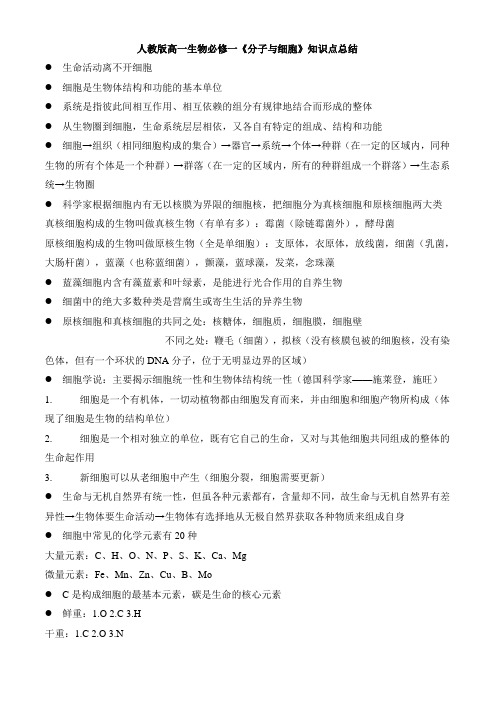
人教版高一生物必修一《分子与细胞》知识点总结●生命活动离不开细胞●细胞是生物体结构和功能的基本单位●系统是指彼此间相互作用、相互依赖的组分有规律地结合而形成的整体●从生物圈到细胞,生命系统层层相依,又各自有特定的组成、结构和功能●细胞→组织(相同细胞构成的集合)→器官→系统→个体→种群(在一定的区域内,同种生物的所有个体是一个种群)→群落(在一定的区域内,所有的种群组成一个群落)→生态系统→生物圈●科学家根据细胞内有无以核膜为界限的细胞核,把细胞分为真核细胞和原核细胞两大类真核细胞构成的生物叫做真核生物(有单有多):霉菌(除链霉菌外),酵母菌原核细胞构成的生物叫做原核生物(全是单细胞):支原体,衣原体,放线菌,细菌(乳菌,大肠杆菌),蓝藻(也称蓝细菌),颤藻,蓝球藻,发菜,念珠藻●蓝藻细胞内含有藻蓝素和叶绿素,是能进行光合作用的自养生物●细菌中的绝大多数种类是营腐生或寄生生活的异养生物●原核细胞和真核细胞的共同之处:核糖体,细胞质,细胞膜,细胞壁不同之处:鞭毛(细菌),拟核(没有核膜包被的细胞核,没有染色体,但有一个环状的DNA分子,位于无明显边界的区域)●细胞学说:主要揭示细胞统一性和生物体结构统一性(德国科学家——施莱登,施旺)1.细胞是一个有机体,一切动植物都由细胞发育而来,并由细胞和细胞产物所构成(体现了细胞是生物的结构单位)2.细胞是一个相对独立的单位,既有它自己的生命,又对与其他细胞共同组成的整体的生命起作用3.新细胞可以从老细胞中产生(细胞分裂,细胞需要更新)●生命与无机自然界有统一性,但虽各种元素都有,含量却不同,故生命与无机自然界有差异性→生物体要生命活动→生物体有选择地从无极自然界获取各种物质来组成自身●细胞中常见的化学元素有20种大量元素:C、H、O、N、P、S、K、Ca、Mg微量元素:Fe、Mn、Zn、Cu、B、Mo●C是构成细胞的最基本元素,碳是生命的核心元素●鲜重:1.O 2.C 3.H干重:1.C 2.O 3.N组成细胞的化合物无机化合物水无机盐有机化合物糖类(甘蔗、甜菜、糖类) 脂类(花生、油菜)蛋白质(大豆)——有机物中最多 核酸盘绕、折叠(结构稳定)统一性:无论鲜重、干重最多的四种元素均为:C 、O 、H 、N● 一切生命活动都不能离开蛋白质,蛋白质是生命活动的主要承担者(肉、蛋、奶和大豆制品)● 氨基酸是组成蛋白质的基本单位,在生物体中组成蛋白质的氨基酸约有20种● 每种氨基酸分子至少都含有一个氨基(-NH 2)和一个羧基(-COOH),都有一个氨基和一个羧基连接在同一个碳原子上,这个碳原子还连接一个氢原子和一个侧链基团 ● 各种氨基酸之间的区别在于R 基的不同● 有8种氨基酸是人体细胞不能合成的,必须从外界直接获取,这些氨基酸叫做必需氨基酸● 在评价各种食物中蛋白质成分的营养价值时,人们格外注重其中必需氨基酸的含量肽酶 蛋白酶 ● 氨基酸→二肽→三肽→多肽→蛋白质● 脱掉的水分子个数=肽键个数=氨基酸个数-肽链条数● 蛋白质的分子量=平均分子量*氨基酸个数-18*(氨基酸个数-肽链条数) ● 每条链至少有一个-NH 2和一个-COOH ● 氨基酸分子互相结合的方式:脱水缩合●多肽通常呈链状结构,叫做肽链。
现代分子生物学 复习笔记

现代分子生物学复习提纲第一章绪论第一节分子生物学的基本含义及主要研究内容1分子生物学Molecular Biology的基本含义广义的分子生物学:以核酸和蛋白质等生物大分子的结构及其在遗传信息和细胞信息传递中的作用为研究对象,从分子水平阐明生命现象和生物学规律。
狭义的分子生物学:偏重于核酸(基因)的分子生物学,主要研究基因或DNA的复制、转录、表达和调控等过程,也涉及与这些过程相关的蛋白质和酶的结构与功能的研究。
1.1分子生物学的三大原则1)构成生物大分子的单体是相同的2)生物遗传信息表达的中心法则相同3)生物大分子单体的排列(核苷酸、氨基酸)的不同1.3分子生物学的研究内容• DNA重组技术(基因工程)•基因的表达调控•生物大分子的结构和功能研究(结构分子生物学)•基因组、功能基因组与生物信息学研究第二节分子生物学发展简史1准备和酝酿阶段时间:19世纪后期到20世纪50年代初。
确定了生物遗传的物质基础是DNA。
DNA是遗传物质的证明实验一:肺炎双球菌转化实验DNA是遗传物质的证明实验二:噬菌体感染大肠杆菌实验RNA也是重要的遗传物质-----烟草花叶病毒的感染和繁殖过程2建立和发展阶段1953年Watson和Crick的DNA双螺旋结构模型作为现代分子生物学诞生的里程碑。
主要进展包括:遗传信息传递中心法则的建立3发展阶段基因工程技术作为新的里程碑,标志着人类深入认识生命本质并能动改造生命的新时期开始第三节分子生物学与其他学科的关系思考证明DNA是遗传物质的实验有哪些?分子生物学的主要研究内容。
列举5〜10位获诺贝尔奖的科学家,简要说明其贡献。
第二章染色体与DNA第一节染色体1. 作为遗传物质的染色体特征 :分子结构相对稳定 能够自我复制能够指导蛋白质的合成,从而控制整个生命过程 ;能够产生遗传的变异。
2真核细胞染色体组成(1) DNA(2) 蛋白质(包括组蛋白和非组蛋白)(3)少量的RNA组蛋白:呈碱性,结构稳定;与 DNA 结合形成、维持染色质结构,与 DNA 含量呈一定的比例非组蛋白:呈酸性,种类和含量不稳定;作用还不完全清楚 3. 染色质和核小体染色质是一种纤维状结构,由最基本的单位 一核小体(nucleosome)成串排列而成的。
生物必修一笔记整理

必修一分子与细胞专题一化学元素、化合物(一)元素1.种类(1)必需元素约20种(2)大量元素(含量万分之一以上): C、H、O、N、P、S、K、Ca、Mg最基本:C 碳架: C、H、O 基本:C、H、O、N 主要:C、H、O、N、P、S(3)微量元素(含量万分之一以下): Mn Zn Cu B Mo Ni Fe 等2.含量含量最多:鲜重(O)干重(C)3.意义元素在无极自然界可找到,说明了生物界、非生物界具有统一性元素质量分数相差大,说明具有差异性(二)水、无机盐1.存在形式(1)水:自由水结合水(2)无机盐:离子(Na+ K+)化合物(CaCO3 骨骼牙齿)2.生理作用(1)水①自由水:良好溶剂参与反应运输物质②结合水:细胞结构③比例:自由水↑,代谢↑;结合水↑,抗旱、抗性↑(2)无机盐①结构成分 Fe 血红蛋白;Mg 叶绿素②调节生命活动渗透压:Na K(缺Na乏力反应迟钝血压降低心率加快四肢发冷缺K 心律不齐)pH :NaHCO3Na2CO3调节:缺Ca 抽搐(3)吸水渗透作用①条件:半透膜浓度差②动物:细胞外液细胞内液渗透压③植物(成熟)质壁分离Ⅰ原理原生质层(细胞膜液泡膜与两者间的细胞质)半透膜,外界溶液与细胞液存在浓度差,成熟的植物细胞液泡大,原生质层小;细胞失水,细胞壁伸缩性小于原生质层。
Ⅱ意义①判断植物死活②证明植物具有渗透系统③判断内外溶液浓度Ⅲ注意浓度不过高,酸碱度适中,时间不过长,尿素溶液、KNO3 溶液会自动复原。
Ⅳ实验方法步骤:(1)制作洋葱表皮临时装片。
(2)低倍镜下观察原生质层位置。
(3)在盖玻片一侧滴一滴蔗糖溶液(3%),另一侧用吸水纸吸,重复几次,让洋葱表皮浸润在蔗糖溶液中。
(4)低倍镜下观察原生质层位置、细胞大小变化(变小),观察细胞是否发生质壁分离。
(5)在盖玻片一侧滴一滴清水,另一侧用吸水纸吸,重复几次,让洋葱表皮浸润在清水中。
(6)低倍镜下观察原生质层位置、细胞大小变化(变大),观察是否质壁分离复原。
高三生物分子生物学知识点总括
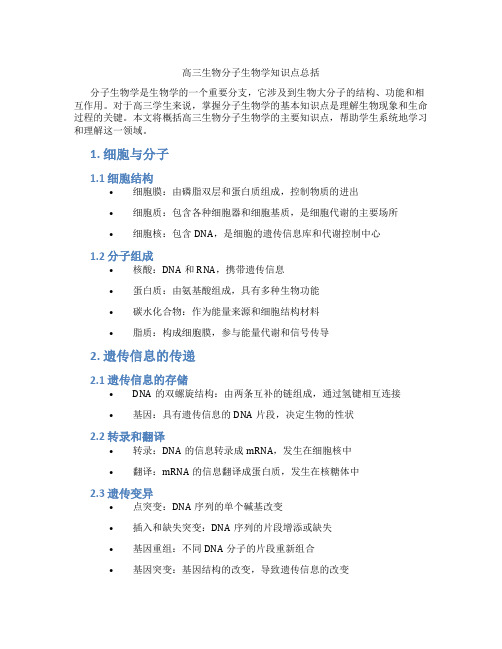
高三生物分子生物学知识点总括分子生物学是生物学的一个重要分支,它涉及到生物大分子的结构、功能和相互作用。
对于高三学生来说,掌握分子生物学的基本知识点是理解生物现象和生命过程的关键。
本文将概括高三生物分子生物学的主要知识点,帮助学生系统地学习和理解这一领域。
1. 细胞与分子1.1 细胞结构•细胞膜:由磷脂双层和蛋白质组成,控制物质的进出•细胞质:包含各种细胞器和细胞基质,是细胞代谢的主要场所•细胞核:包含DNA,是细胞的遗传信息库和代谢控制中心1.2 分子组成•核酸:DNA和RNA,携带遗传信息•蛋白质:由氨基酸组成,具有多种生物功能•碳水化合物:作为能量来源和细胞结构材料•脂质:构成细胞膜,参与能量代谢和信号传导2. 遗传信息的传递2.1 遗传信息的存储•DNA的双螺旋结构:由两条互补的链组成,通过氢键相互连接•基因:具有遗传信息的DNA片段,决定生物的性状2.2 转录和翻译•转录:DNA的信息转录成mRNA,发生在细胞核中•翻译:mRNA的信息翻译成蛋白质,发生在核糖体中2.3 遗传变异•点突变:DNA序列的单个碱基改变•插入和缺失突变:DNA序列的片段增添或缺失•基因重组:不同DNA分子的片段重新组合•基因突变:基因结构的改变,导致遗传信息的改变3. 分子生物学技术3.1 分子克隆•克隆DNA:通过PCR扩增特定的DNA片段•克隆基因:将外源基因插入载体DNA,转化细胞进行表达3.2 基因测序•Sanger测序:通过链终止法测定DNA序列•第二代测序技术:如Illumina测序,高通量测定DNA序列3.3 蛋白质分析•蛋白质提取和纯化:通过离心、凝胶色谱等技术分离蛋白质•蛋白质鉴定:通过Western blot、质谱等技术分析蛋白质4. 分子生物学在生物研究中的应用4.1 基因功能研究•基因敲除:通过CRISPR等技术消除特定基因的功能•基因过表达:通过载体转染等技术增加特定基因的表达4.2 疾病研究•分子诊断:通过检测特定的基因或蛋白质来诊断疾病•基因治疗:通过修复或替换异常基因来治疗疾病4.3 生物技术应用•重组蛋白的生产:通过转基因微生物或细胞培养生产药物和疫苗•基因工程作物:通过基因改造提高作物的抗病性和产量分子生物学是一个快速发展的领域,对于高三学生来说,理解和掌握分子生物学的基本知识点是重要的。
Biological Molecules
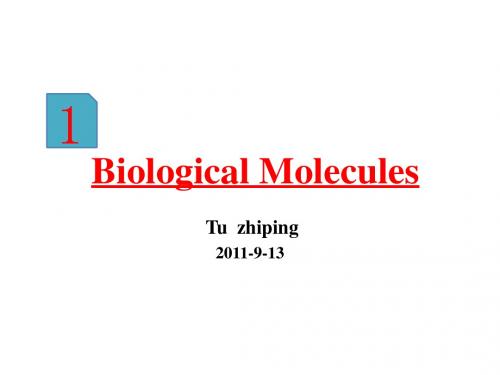
B=腺嘌呤,鸟嘌呤,胞嘧啶,尿嘧啶或胸腺密啶
多聚核苷酸
• 在多聚核苷酸中,两个核苷酸 之间形成的磷酸二酯键通常称 为3′→5′磷酸二酯键,构成无 分支结构的线性分子。 • 多聚核苷酸链一端的C5′带有 一个自由磷酸基,称为5′-磷 酸端(常用5’-P表示);另一 端C3’带有自由的羟基,称为 3′-羟基端(常用3’-OH表示 )。 • 多聚核苷酸链具有方向性,当 表示一个多聚核苷酸链时,必 须注明它的方向是5′→3′或 是3′→5′。
或核糖
戊糖(pentose) • 组成核酸的戊糖有两种。DNA所含 的糖为β-D-2-脱氧核糖;RNA所含 的糖则为β-D-核糖。
HOCH2 H H OH O H H OH H OH H OH HOCH2 H O H H OH
D-核糖
D-2-脱氧核糖
5’
4’ 3’ 2’
5’
1’
4’ 3’ 2’
• 生物高分子是由许多小单位组成的大分子,是具 有精确长度和确定序列的聚合物。 • 它们通过非共价相互作用折叠或结合成特定的构 象集合。
• This (usually) happens in water. • The molecules are the (usually) successful outcomes of biological evolution. • 我们今天看到的分子是经过数百万年数不 尽的随机实验得来的结果,在这期间生物系统 已经进化到可以利用物理化学的精细原理,这 些我们至今还没有弄清楚。
• (1)DNA分子由两条多聚脱氧核糖核苷酸链(简称 DNA单链)组成。两条链沿着同一根轴平行盘绕, 形成右手双螺旋结构。螺旋中的两条链方向相反, 即其中一条链的方向为5′→3′,而另一条链的 方向为3′→5′。
- 1、下载文档前请自行甄别文档内容的完整性,平台不提供额外的编辑、内容补充、找答案等附加服务。
- 2、"仅部分预览"的文档,不可在线预览部分如存在完整性等问题,可反馈申请退款(可完整预览的文档不适用该条件!)。
- 3、如文档侵犯您的权益,请联系客服反馈,我们会尽快为您处理(人工客服工作时间:9:00-18:30)。
Chapter 2: Biological moleculesThe building blocks of life4 most common elements in living organisms: hydrogen, carbon, oxygen and nitrogen (in order of abundance) Organic molecules always contain carbon and hydrogenMonomers, polymers and macromoleculesMacromolecules: giant biological molecules-polysaccharides,proteins and nucleic acids (are all polymers)Polymers: giant molecules made from many similar repeatingsubunits (monomers) joined together in a chainMonomers: relatively simple molecules which are used as basicbuilding blocks for the synthesis of polymers-monosaccharides,amino acids and nucleotidesCarbohydratesAll carbohydrates contain the elements carbon, hydrogen and oxygenHydrate refers to waterGeneral formula: C x(H2O)yCarbohydrates are divided into 3 main groups: monosaccharides, disaccharides and polysaccharides Saccharide refers to a sugar or sweet substanceMonosaccharidesMonosaccharide: a molecule consisting of a single sugar unit with the general formula (CH2O)nGeneral formula: (CH2O)nMonosaccharides are sugarsClassified according to the number of carbon atoms in each molecule: trioses (3C) pentoses (5C) and hexoses (6C) Common hexoses: glucose, fructose and galactoseCommon pentoses: ribose and deoxyribose➢Molecular and structural formulaeMolecular formula for a hexose: C6H12O6Structural formula: a diagram that shows the arrangements of the atoms➢Ring structuresFor pentoses and hexoses, thechain of carbon atoms is longenough to close up on itself andform a more stable ring structureɑ-glucose: hydroxyl group, -OH,on carbon atom 1 is below theringβ-glocose: -OH is above the ringIsomers: two forms of the samechemical➢Roles of monosaccharides in living organismsTwo major functions:1.A source of energy in respiration: the carbon-hydrogen bonds can be broken to release a lot of energy, which is transferred to help make ATPGlucose-the most important monosaccharide in energy metabolism2.Building blocks for larger moleculesDisaccharides and the glycosidic bondDisaccharide: sugar molecule consisting of two monosaccharides joined together by a glycosidic bond Disaccharides are sugarsCommon disaccharides: maltose, sucrose and lactoseMaltose=glucose+glucoseSucrose (in plants) =glucose+fructoseLactose (in milk) =glucose+galactoseLactose is an important constituent of the diet of young mammalsCondensation: the process of two monosaccharides joining together with a glycosidic bond by losing waterTwo hydroxyl (-OH) groups line up alongside each otherOne combines with a hydrogen atom form the other to form a H2O moleculeGlycosidic bond: oxygen bridge between the two moleculesHydrolysis: the reverse of condensation-disaccharides or polysaccharides are broken down to monosaccharides by adding waterPolysaccharidesPolysaccharides: polymers whose subunits are monosaccharides joined together by glycosidic bondsCommon polysaccharides: starch, glycogen and cellulosePolysaccharides are NOT sugarsIf glucose accumulated in cells-dissolve and make the contents of the sells concentrated→affect osmotic properties-interfere with normal cell chemistry because glucose is reactiveSo glucose is converted into starch (in plants) and glycogen (in animals)➢Starch and glycogenStarch is a mixture of amylose and amylopectinAmylose is made by condensations between ɑ-glucose moleculesA long, unbranching chain of 1,4 linked glucose molecules--curved and coil up, a helix shape--makes the final molecule more compactAmylopectin is also made of many 1,4 linked ɑ-glucose molecules--shorter chains than in amylose--branch out to the sides, the branches are formed by 1,6 linkagesGlycogen is made of chains of 1,4 linked ɑ-glucose with 1,6 linkages forming branches--more branched than amylopectin moleculesGlycogen molecules clump together to form granules (visible in liver cells and muscle cells)CelluloseA polymer of β-glocose--as a structural role--one glucose molecule must be upside down relative to the other→this arrangement results in a strong moleculeCellulose make up about 20-40% of the average cell wallCellulose fibers:--have a very high tensile strength→very difficult to tostretch or break→makes it possible for a cell towithstand the large pressures that develop within it as aresult of osmosis--freely permeable, allowing water and solutes to reachor leave the cell membraneCell wall’s function:--provide support for the plant by making tissues rigid--responsible for cell expansion during growthWithout cell wall: burst when in a dilute solutionDipoles and hydrogen bondsWhen atoms in molecules are held together by covalent bonds, they share electrons with each otherEach shared pair of electrons forms one covalent bondHowever, the electrons are not shared absolutely equallyIn water, the oxygen atom gets slightly more than its fair share, and so has a small negative charge, written δ−(delta minus)The hydrogen atoms get slightly less than their fair share, and so have a small positive charge, written δ+ (delta plus)This unequal distribution of charge is called a dipoleHydrogen bond: the negatively charged oxygen of one molecule is attracted to a positively charged hydrogen of anotherDipoles occur in many different molecules, particularly wherever there is an –OH, –CO or –NH group. Hydrogen bonds can form between these groups,。
